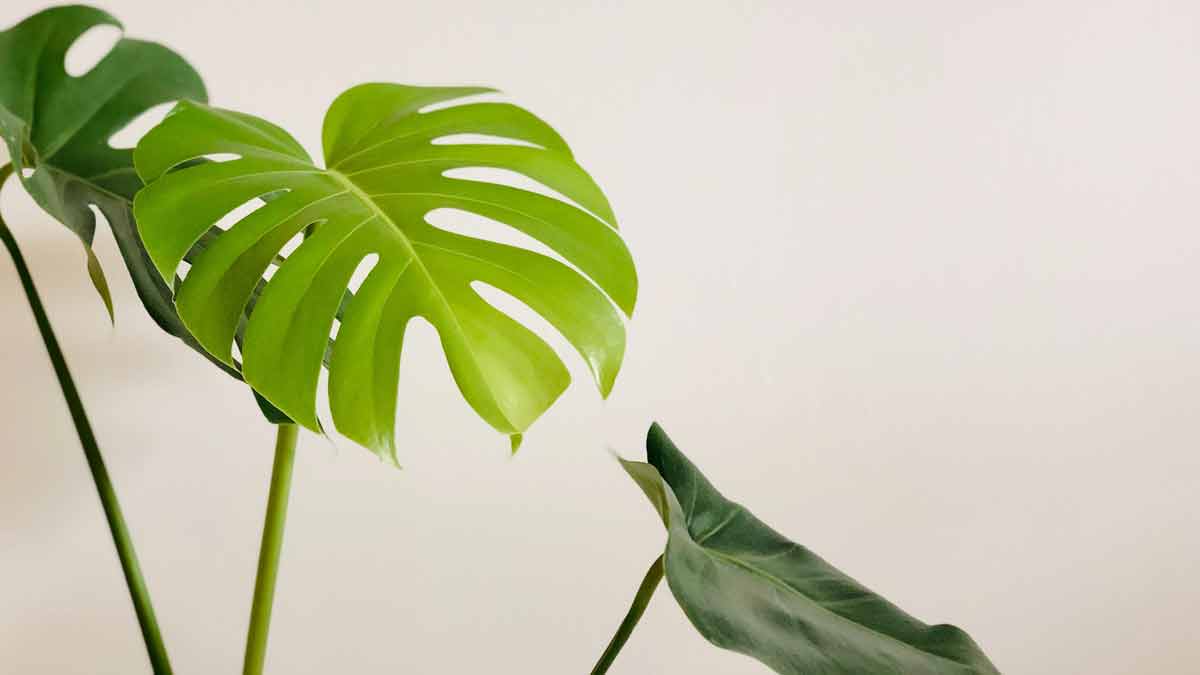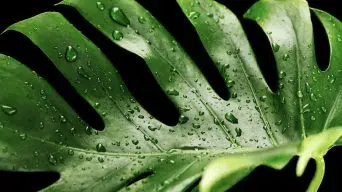Monstera plants prefer medium to high humidity levels between 60% to 70% and can survive in a wider range. To increase humidity, mist it regularly, use a humidifier or pebble tray or group it with other plants.
Monstera plants, also known as the Swiss Cheese Plant, are a popular choice for indoor gardens, with their large leaves and distinctive split-leaf pattern making them an attractive addition to any home.
But how do you keep these delicate houseplants healthy?
One of the key elements is humidity – so just how much humidity does a Monstera need?
In this article, we’ll look at what levels of humidity are ideal for your Monstera plant and offer some tips on how to manage it in your home.
Importance of Humidity for Monstera Plants
Humidity is crucial for the growth and health of Monstera plants.
These tropical plants are native to Central and South America and thrive in warm and humid environments. In their natural habitat, they receive moisture from both rain and humidity in the air.
The leaves of the Monstera have many pores that absorb water from the air.
When the air is dry, these pores can become clogged with dust and debris, which can inhibit the plant’s ability to absorb moisture. This can lead to stunted growth and even cause the leaves to turn brown or yellow.
Humidity isn’t just good for your Monstera plants – it can also help protect them from pests.
Insects such as aphids, mealybugs, mites, and scale are often drawn to dry environments, but when humidity levels are kept high, these pests won’t be as likely to invade your prized houseplant!
However, you should also remember that too much humidity can be just as bad for your Monstera.
High moisture levels can lead to root rot or other fungal diseases, so it’s important to find the right balance of humidity.
Ideal Humidity Range for Monstera Plants
One important factor to consider when caring for a Monstera is humidity. The ideal range for a Monstera is 60-70% humidity.
This means that the air around the plant should contain 60-70% of the maximum amount of water vapor it can hold at a given temperature.
Low humidity can cause leaves to turn yellow or brown, and the plant may wilt. This is because the Monstera needs a certain level of moisture in the air to thrive.
If you live in an area with low humidity, you may need to take steps to increase the moisture around your plant. One way to do this is by using a humidifier or placing a tray of water near your plant.
On the other hand, high humidity can lead to mold growth on the plant. This can be harmful to both the plant and anyone who comes into contact with it.
To prevent mold growth, make sure your Monstera has good air circulation and avoid overwatering.
Relative humidity not only affects Monstera plants but also plays an important role in overall plant growth.
Different plants have different ideal humidity ranges, so it’s important to do your research before bringing any new plants into your home.
If you want your Monstera plant to thrive, make sure it’s in an environment with 60-70% relative humidity.
By paying attention to this important factor, you’ll be able to enjoy healthy, vibrant leaves on your beautiful Swiss Cheese Plant.
Measuring and Maintaining Humidity Levels
Plants require a specific level of humidity to thrive.
Too much or too little humidity can cause stress and damage to your plants. Therefore, measuring and maintaining the proper humidity levels is crucial for plant health.
Measuring Humidity Levels
The first step in maintaining proper humidity levels is to measure the current level of humidity. This can be done using a hygrometer, which measures the moisture meter.
Many types of hygrometers are available on the market, but not all are suitable for plant monitoring.
We recommend using a digital thermometer/hygrometer with a remote sensor probe for accurate readings.
This type of hygrometer allows you to monitor the temperature and humidity levels in real time from a distance without disturbing your plants.
Maintaining Consistent Humidity Levels
Once you have measured the current humidity level, it’s time to maintain a consistent level that is suitable for your plants’ needs.
Here are some tips on how to do so:
- Group Your Plants: Placing plants together can create a microclimate that increases humidity levels around them.
- Use A Humidifier: A humidifier effectively increases moisture in the air around your plants.
- Mist Your Plants: Spraying water on your Monstera plants enhances their moisture absorption and elevates the surrounding humidity levels.
- Use Pebble Trays: Placing pebbles in trays filled with water under your plant pots can help increase humidity levels around them.
- Give Them A Bath: Giving your plants a bath by placing them in a tray filled with water for 30 minutes can help increase their moisture intake and raise humidity levels around them.
- Place Them In More Humid Rooms: If possible, move your plants to rooms with higher natural humidity levels, such as bathrooms or kitchens.
Adjusting Humidity Levels
It’s important to adjust the humidity level according to your plant’s needs as they grow or during different seasons.
Some tropical plants require higher humidity levels than others, while others prefer lower levels during winter when indoor heating dries out the air.
Regularly monitoring and adjusting the humidity level using our recommended digital thermometer/hygrometer ensures that your plants receive optimal care throughout their growth cycle.
Signs That Your Monstera Needs More Humidity
If your Monstera isn’t getting enough humidity, it can show signs of distress.
Some signs that your plant needs more humidity include:
Yellow or Brown Leaves
One of the most obvious signs that your Monstera needs more humidity is if you notice yellow or brown leaves.
This is because low humidity can cause the plant to lose moisture through its leaves faster than it can absorb it from the soil.
As a result, the Monstera leaves will turn yellow or brown and eventually fall off.
Wilting Leaves
Another sign that your Monstera needs more humidity is if you notice wilting leaves.
This is because low humidity can cause the plant to lose water faster than it can absorb it from the soil. As a result, the Monstera leaves will start to droop and wilt.
Leaves Dropping Off
If you notice that your Monstera is losing a lot of leaves all at once, this could be a sign that it needs more humidity.
When there isn’t enough moisture in the air, the plant will start shedding its foliage as a way to conserve water.
Dust on Leaves
Dust on the leaves may seem like an unrelated issue, but in fact, it’s also an indicator of dryness.
When there isn’t enough moisture in the air, dust particles tend to stick to plants’ surfaces as they cling to any available moisture.
This can cause leaves to become dry and brittle.
How to Increase Humidity for Monstera Plants
Monstera plants are tropical rainforest plants that thrive in high humidity environments. It might be due to low humidity levels if you’re struggling to keep your Monstera healthy.
Fortunately, there are simple ways to increase humidity for your Monstera plants:
Grouping Plants Together
One simple way to increase the humidity for your Monstera is by grouping them together.
When plants are grouped together, they release water vapor into the air through a process called transpiration.
This can create a microclimate with higher humidity levels around your Monstera plants.
Apart from increasing humidity levels, grouping plants together can also help create a more aesthetically pleasing display.
Plus, it’s an easy and cost-effective way to boost the humidity around your Monstera!
Using a Tray with Pebbles
Another easy way to increase the humidity for your Monstera is by using a tray with pebbles.
Fill a tray with pebbles and add water until it reaches just below the surface of the pebbles.
Then place your Monstera on top of the pebbles.
As the water evaporates from the tray, it will create moisture in the air around your plant.
This is a great way to boost humidity levels without having to invest in costly humidifiers.
Using a Humidifier in the Room
If you want to take things up a notch, consider using a humidifier in the room where your Monstera is located.
A humidifier adds moisture to the air, which can help keep your plant healthy and happy.
Be sure to choose a humidifier appropriate for your room’s size and follow the manufacturer’s instructions for use.
Enclosures such as Sealed Greenhouse or Terrarium
For those who want to create an enclosed environment for their Monstera, consider using a sealed greenhouse or terrarium.
These enclosures trap moisture inside and create high humidity levels that are perfect for tropical plants like Monstera.
The benefits of enclosing your Monstera in a greenhouse or terrarium extend beyond just humidity; they also provide protection from pests and other environmental elements.
Water Features such as Pebble Tray or Small Fountain
Adding water features like a pebble tray or small fountain can also help increase humidity levels around your Monstera plant.
The sound of running water can be soothing and relaxing while also providing much-needed moisture in the air.
Pebble trays and small fountains are also great additions to any indoor space.
Different Humidity Needs for Variegated Monstera
If you’re a plant lover, chances are you’ve heard of the variegated Monstera.
Variegated Monstera plants, like the Monstera deliciosa ‘Variegata’ or the rare and expensive Monstera Albo, are prized for their gorgeous foliage and can really liven up any indoor space.
But did you know that maintaining the delicate variegation of this plant requires specific humidity levels?
Myth: Super High Humidity is Necessary to Prevent Browning on the Edges
One of the most common misconceptions about variegated Monstera is that they require super high humidity levels to prevent browning on the edges of their leaves.
While it’s true that these plants prefer higher humidity levels than some other houseplants, excessively high humidity can actually be detrimental to their health.
Importance of Some Humidity for Variegated Monstera
So, what is the ideal humidity level for a variegated Monstera?
The answer may surprise you. While these plants do prefer medium to high humidity levels, they don’t require anything extreme.
In fact, keeping your plant in an environment with too much moisture can lead to issues like root rot and fungal growth.
The ideal range for a variegated Monstera is between 60-85% humidity.
If your home is particularly dry or you live in an area with low humidity levels, there are several ways to increase the moisture around your plant.
Final Thoughts
Monstera plants love humidity and need lots of it to thrive.
It’s important to keep the air around your plant moist and make sure it doesn’t get too dry.
If you have a Monstera in your home or garden, adding some extra moisture into the air is essential for helping it grow healthy and strong!
With proper care, your Monstera will be sure to thank you!
Happy Planting!







